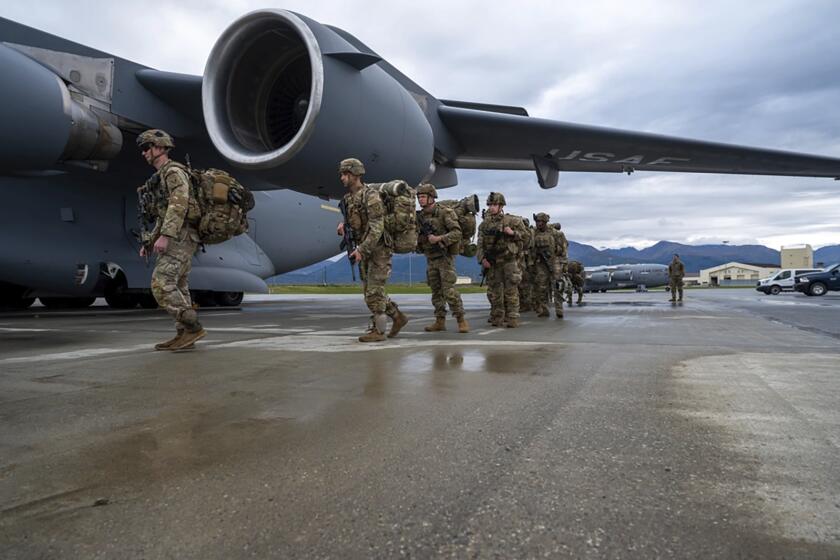Facing Death on a Dark Mountain in Kurdistan
The moon is quarter-full and bright. Ambush teams fan into the valley below, their radios squawking every now and then. Somebody jokes that this land is harsh, a place where even souls decay. The machine-gunner in the bunker doesn’t laugh. He doesn’t blink. He just peers through his scope for an enemy in the night.
Kurdish Maj. Fatih Abdullah Faraj was shot not long ago. The bullet shattered some teeth. Mortars killed two fighters he knew. Others had their throats slit. One was struck by lightning. Life here can end in any number of ways. The Kurdish peshmerga -- “those who face death” -- own this northern Iraq mountain range during the day. Their grasp is more tenuous at night. It is then that the Islamic militants of Ansar al-Islam often strike.
“Ansar has tricks,” says Faraj, crouching behind a stone wall.
“We thought they might attack last night,” whispers a voice in the dark.
“Nothing moving,” says machine-gunner Sherzad Omer Ahmed, a ski mask softening his silhouette against the moonlight.
In this corner of Iraq, known as Kurdistan, a battle is being waged in the shadow of the larger conflict unfolding between Baghdad and Washington. About 3,000 peshmerga of the Patriotic Union of Kurdistan, or PUK, are fighting from 500 to 700 mostly Kurdish Muslim extremists, some trained in the Al Qaeda camps of Afghanistan.
The PUK’s fighters are attempting to stop Ansar from advancing farther into a region where 3.5 million Kurds live autonomously, protected from the Iraqi army by a “no-fly” zone patrolled by U.S. and British planes. The peshmerga force camped on this mountain is a collection of those who’ve never been battle-tested and those who carry shrapnel and bullet scars from decades of bloodshed.
They are led by Cmdr. Kakamand Kakarush, a thick-shouldered man with a broad face and a belt full of Kalashnikov cartridges. He is the one, a stern father with a soft voice, who walks the night, visiting bunkers, talking to his men, making sure they each have the allotted 120 bullets. Ammunition is scarce; no one shoots unless he’s pretty sure of nailing something.
Between his rounds, the commander sits in the lamplight of the “teahouse,” a mud-walled headquarters with a roof of corrugated metal and dirt. Most here believe the roof would stop a mortar shell, but more powerful artillery fire, no way. The commander fiddles with a shortwave radio, stopping the dial where Cher is singing “Strong Enough.” He doesn’t understand the words; it’s more the music he likes.
The air outside is still.
Shuffling boots pass beyond the window.
Another fighter pokes his head in and gives the commander an update. Nothing moving.
Like many of the men in his unit, the commander fought in the Kurdish uprising against Iraqi President Saddam Hussein after the 1991 Persian Gulf War. The Americans left the peshmerga vulnerable by not suppressing the Iraqi army, and the Kurds were easily defeated.
The commander is not bitter, though. He was shot in the thigh five years later during a Kurdish civil war. Now he’s fighting again, leaving his wife and children in the city of Sulaymaniyah, about 50 miles away, for two-week shifts in the hills.
“When this is all over, I’d like to live in peace,” he says. “The Kurds have been through a lot, through much war. We need a rest.” The night is cold. Starlight reflects off the snow. The red lights of a plane flash miles away, skimming beyond the big peaks along the Iraq-Iran border. Some peshmerga gather and watch. Maybe a U.S. airstrike is coming. Maybe the big war is beginning. An Ansar mortar round echoes from a distant valley. Then another. The ambush teams radio in. Nothing moving.
Village lights shimmer below. Quiet. Sometimes it’s so quiet, a fighter moves just so he can hear something. No one sleeps. The last time a unit slept, six Ansar guerrillas, barefoot and silent, crept into a camp at Girda Drozna. They were joined by a larger contingent of Muslim extremists, one of whom videotaped the battle. More than 40 peshmerga were killed, many of their bodies mutilated.
When a fighter looks down from these heights, he can see the dangerous pocket that is his world. Ansar, which has imposed a Taliban-like fundamentalist rule over a handful of villages, is across the narrow valley. Iraqi troops are camped to the south. Iran is due east. Each would like to see the Kurds destroyed.
“I was born in 1963,” says Faraj, the major. “Even before then my grandfather was fighting for freedom in this country. I’ve fought in three wars. The uprising against Saddam, the civil war between the Kurds, and this one.... But these guys we’re fighting now, I don’t understand. What’s happening here and what happened in the U.S. is only different by the size of the terrorist attacks. Ansar wants to intimidate. We’re trying to contain them. We’re standing on their face to keep them out of our cities.”
Ahmed, the 28-year-old machine-gunner, joined the peshmerga when he was 16. He’s a willowy man in camouflage fatigues and a pair of sneakers. The fighters are low on boots, gloves and medic kits.
Ahmed is the point man in this bunker; his black PKC machine gun pokes over the rock wall. “I’ve seen almost all of Kurdistan,” he says. “When there was a battle, I was there.”
When asked why he joined at so young an age, he looks confused and a little angry. “It was my choice,” he says, angling his gun and looking for a wrinkle in the night.
Azad Qadir is 22. He crouches on a rock with his Kalashnikov rifle. A grenade dangles from his belt. Standing guard at night requires all his senses. You study the terrain, he says, and if something changes, something’s wrong.
“I’ve been in two battles,” he says. “I’ve shot bullets, but God knows if I ever hit anyone.”
The peshmerga are mythic. They are the stuff of campfire stories about men fighting with gun and knife and fist until the end. Hussein called one peshmerga commander an “iron man” because of his bravery against Iraqi troops. But the fighters have been denied what they and most Kurds desire: a nation.
When the Ottoman Empire was carved up after World War I, the Kurds -- a non-Arab people who today number about 25 million spread primarily over four countries -- did not receive the state they felt was promised to them. They aren’t likely to get it if Hussein is toppled either. Pressure from U.S. officials and Iraq’s neighbors, Turkey and Iran, which fear their own Kurds’ ambitions for independence, would probably mean that the Kurds of Iraq would settle for living in a federation under a central government in Baghdad.
The peshmerga in this bunker don’t seem to mind. They sense history is not with them, and that larger forces, those beyond rifle range, will make the rules.
“I cannot tell for sure what will happen. It’s all politics,” says Akram Hassan Arif, a silver-haired operations officer, who is so dapper that he moves among the other fighters as if he’s an actor on a movie set. “We just want Saddam to go away. We don’t talk much of independence. Those surrounding us don’t welcome that idea.”
The ambush teams return to base. Ansar is still; nothing moving. 4:58 a.m.
Then 5:31. And then 6:03. There is no seam between night and dawn. One world seeps into the other. The peshmerga in the bunker know this. Sometimes dawn just doesn’t burn across the sky fast enough, illuminating the ledges, the crevices, the farm fields and the rocky land separating them from Ansar. When dawn does come, though, eggs are fried, and the clinking of teaspoons is a kind of music. There are jokes.
Even tired feet are swift.
Some guys sun themselves on the rocks, and through binoculars one can see that the Ansar militants are doing the same. Mortar fire will resume as the day wears on. Sometimes as many as 30 rounds a day whistle through the valley. But dawn seems to calm everyone. Even machine-gunner Ahmed.
“I’m going to sleep,” he says.
More to Read
Sign up for Essential California
The most important California stories and recommendations in your inbox every morning.
You may occasionally receive promotional content from the Los Angeles Times.











